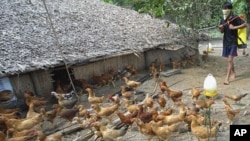Health officials in Cambodia say they have so far not detected a new strain of the bird flu virus that appeared recently in Vietnam.
Bird flu, or avian influenza, has killed at least eight Cambodians so far this year, and the UN’s Food and Agricultural Organization warned Cambodian authorities in August that a new strain in Vietnam had the potential of crossing into Cambodia.
“Virus circulation in Vietnam poses a direct threat to Cambodia,” the FAO said in a statement, adding that the new strain represents “unpredictable risks.”
Ly Sovann, deputy director of the Ministry of Health’s communicable diseases department, told VOA Khmer Thursday that doctors and specialists of infectious diseases at the ministry, the World Health Organization and the Pasteur Institute have tested samples of bird flu found in Cambodia and they are not of the new strain.
Bird flu, which can pass between wild birds and domestic fowl, and from birds to humans, has so far not made the evolutionary jump that would allow it to easily pass from human to human, a major concern of health officials since the disease appeared in 2003.
“At the moment, we have not seen any sustained spread of the avian influenza virus from human to human anywhere in the world,” said Nima Asgari, a public health specialist in Cambodia for the WHO.
Cambodian health officials are carefully watching for the new Vietnamese strain to appear, both men said.
However, Ly Sovann noted a jump in the numbers of Cambodians affected by the original strain, officially known as “A/(H5N1).” The virus spread from the border area of Vietnam to the border area of Thailand this year, but it does not pose a serious worry, he said.
“AH5N1 cases this year are stranger than 2010,” he said. “From January to August, 2011, we had eight people die from the AH5N1 virus. This virus always occurs reaching into April, but this year, it reached into August.”
That means the total number of deaths in 2011 accounts for fully half of 16 deaths in Cambodia since 2003.
Asgari said the reason behind the increase was not yet clear, but he said it is possible that health officials are more aware of the disease and may be detecting it more easily.
“We still need to make sure that clinicians in other hospitals are also aware of the likelihood of avian influenza and can ask for the testing of suspect cases,” he said.
Ly Sovann said the government is training clinicians in the provinces to better understand bird flu and watch for the appearance of the new strain. They will be able to treat patients or refer them more quickly, he said. They will also be able to investigate the source villages of any bird flu outbreak, he said.
Tep Sam Oeurn, chief of Prey Veng’s provincial office of communicable diseases, said that more than 100 health officials and 1,130 village responders have been trained to monitor for the disease and help treat if quickly.
“If we suspect AH5N1, such as if the patient has touched dead chickens or dead ducks and then he or she has a cough, sore throat and other symptoms, he or she should visit the hospital as soon as possible,” he said. “Now we have already supplied medicine to the hospitals.”
Don Tha, the head of a health center in Rohat Teuk commune, in Banteay Meanchey province’s Mongkul Borei district, said he was mindful of a return of the disease, which killed a 4-year-old girl in the commune in August.
The girl’s aunt, Long Deurm, 45, said her niece died after eating poultry suspected of having died from the disease.
“I dare not eat dead chickens or ducks because I’m afraid of the spread of the AH5N1 virus,” she said. “If there are dead chickens, I won’t touch or eat them any more.”




